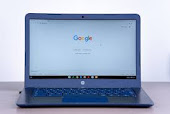Blog Post # 4
The R. A. T. Pack
The R. A. T. Model and the Chromebook
Old School v/s New School…
As I reflect on the R. A. T. model, I think back to my first year of teaching in 2004. I had accepted a job back in my hometown and was teaching in a brand-new building. I had a whiteboard (with plenty of colorful expo markers), a television (hoisted on a stand in the corner), and an overhead projector with basic visa-vis pens (I had to be careful about turning off the bulb too quickly as to not damage the bulb). To access the web, students went to computer labs and used bulky, stationary desktop computers. Today, computer labs are almost a thing of the past as technology has evolved and the bulky desktops of the past are now sleek, affordable, light weight, and portable devices that can be used to access and share information quickly and efficiently.
Chromebooks in the Classroom Craze
What is a Chromebook? Google’s support explains, “Chromebooks are a new type of computer designed to help you get things done faster and easier. They run Chrome OS, an operating system that has cloud storage, the best of Google built-in, and multiple layers of security”. Users can also access some applications offline. Chromebooks offer access to information in the comfort of a students’ home, classroom, or even on the go.
The R. A. T. Model and Chromebooks in the Classroom
R. A. T. is an assessment model that teachers can utilize to analyze and evaluate how to effectively integrate technology into their teaching, learning, and curriculum practices. There are 3 components: replacement, amplification, and transformation.
1. Replacement -
Hughes (2020) defines replacement as, “Technology used to replace and, in no way, changed established instructional practices, student learning process, or content goals”. An example of this component would be a teacher taking a worksheet and sharing a PDF onto his/her student’s chrome book. No instructional practices were changed, just the method of delivery.
2. Amplification -
Hughes (2020) explains amplification as, “technology increases efficiency, effectiveness, and productivity of instructional practices, student learning processes, or content goals”. When a teacher takes a worksheet and places it on an application like Google Slides, students can use the application and work on the problems individually or collaborate, in real time, with a group. Additionally, teachers can view students' work comment and/or give feedback immediately.
3. Transformation -
The last component of Hughes model is transformation. It is described as, “technology reinvents aspects of instruction, learning, or curriculum in new and original ways” (Hughes, 2020). Instead of giving students a PDF copy of a worksheet, students can use their Chromebook to access applications in which they can collaborate with each other and connect and apply their learning with real-world applications. An example might be instead of a math teacher giving students problems for decimal operations, students create their own “dream vacation” presentation (in which they find the total cost, decimal operations) using their chrome books. The presentation can be worked on individually and/or simultaneously in groups with 1:1 chrome book access. Another idea might be to have students explore the concept of area with their chrome books using a website like https://phet.colorado.edu/en/simulation/area-model-multiplication or even having students design their own space virtually by applying the concept of area with https://cospaces.io/edu/. Curious about ways you can use chrome books in your classroom? Check out these links below.
References
Evans, B. & Gierke, T. (n.d.). Google in education: 30 ways to use chrome books in schools. Retrieved from https://www.oakparkusd.org/cms/lib/CA01000794/Centricity/Domain/951/Ways%20to%20use%20Chromebooks%20in%20the%20Classroom.pdf
Fink, J. L. W. (n.d.). Chromebooks in the classroom. Retrieved from https://www.scholastic.com/teachers/articles/teaching-content/chromebooks-classroom/
Hughes, J. E. (2020). Replacement, amplification, and transformation: The R.A.T. Model. Tech Edges. https://techedges.org/r-a-t-model/




Hi Richelle,
ReplyDeleteThanks for analyzing Chromebooks using the R.A.T. model. This year, teaching with a Chromebook has replaced using paper,allowed students to express their knowledge of material by increasing their creativity and transformed our instruction with the many applications that can be combined with the Chromebook.
Thank you for your comment! :-) Yes, having Chromebooks and the various applications have opened doors for new learning modes and opportunities.
Delete